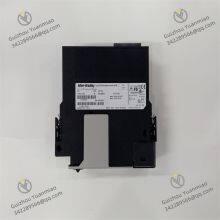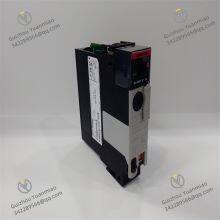I. Overview
1756-L72S is a high-performance Programmable Automation Controller (PAC) in the ControlLogix series under Rockwell Automation, designed specifically for complex industrial automation control scenarios. It combines the stability of PLCs, the processing power of PCs, and the flexibility of distributed control systems, enabling precise control and coordinated management of large-scale, high-complexity industrial processes.
As a core component of the ControlLogix system, the 1756-L72S features powerful data processing capabilities, rich communication interfaces, and high scalability. It is widely applicable to large-scale automated production lines and complex equipment control in various industries such as automotive manufacturing, metallurgy, chemical engineering, electric power, and food and beverage, providing reliable control core support for intelligent manufacturing in the context of Industry 4.0.

II. Technical Parameters
Processor performance: Equipped with a high-performance processor with fast computing speed, supporting large-scale program execution and complex control algorithms (such as PID control, motion control, logic control, etc.). Its processing capacity is usually measured in thousands of instructions per second (KIPS), and the specific value can be found in the product manual. It can meet the needs of multi-task parallel processing, ensuring the real-time and efficiency of control tasks.
Memory configuration: Equipped with a large capacity of memory, including program memory and data memory. Program memory is used to store user-written control programs, and data memory is used to temporarily store process data, intermediate variables, etc., providing sufficient space for the operation of complex programs and the processing of large amounts of data. For example, the program memory can reach tens of megabytes, and the data memory also has a corresponding large-capacity configuration (specific parameters are subject to the product manual).
Power supply requirements: Usually needs to be powered by a 1756 series power module. The input voltage range complies with industrial standards (such as 120V AC/240V AC), and the output is a stable DC voltage (such as 5V DC, 24V DC), providing reliable power support for the controller and related I/O modules to ensure stable operation of the system.

Communication interfaces: Built-in multiple communication ports, supporting mainstream industrial communication protocols such as EtherNet/IP, ControlNet, DeviceNet, etc. Among them, the EtherNet/IP interface can realize high-speed data interaction with HMI (Human-Machine Interface), SCADA (Supervisory Control And Data Acquisition) systems, other controllers, and intelligent devices, meeting the interconnection needs in the Industrial Internet of Things (IIoT) environment.
I/O module compatibility: Compatible with various I/O modules of Rockwell Automation's 1756 series, including digital input/output modules, analog input/output modules, and special function modules (such as motion control modules, high-speed counting modules, etc.). It exchanges data with I/O modules through the backplane bus, supports distributed I/O configuration, and can flexibly expand the number of I/O points of the system to adapt to control needs of different scales.
Environmental adaptability:
Operating temperature: Generally can work stably in the range of 0°C - 60°C, and can adapt to common temperature changes in industrial sites.
Relative humidity: Can operate normally in a relative humidity environment of 5% - 95% (non-condensing), suitable for humid production workshops and other environments.
Vibration and shock resistance: Complies with relevant industrial standards (such as IEC 61131-2), has certain vibration and shock resistance capabilities, and can work reliably in industrial occasions with slight vibrations.

III. Functional Characteristics
Powerful control capability: Supports multiple control methods, including logic control, sequence control, process control, motion control, etc., and can realize integrated control of complex industrial processes. For example, in an automobile welding production line, it can not only control the welding action sequence of robots but also accurately adjust process parameters such as welding temperature and pressure, and coordinate the linkage between various equipment.
High reliability and availability: Adopts redundant design options (such as power supply redundancy, processor redundancy). When the main equipment fails, the standby equipment can switch quickly to ensure uninterrupted operation of the system and minimize production downtime. At the same time, it has a complete self-diagnostic function, which can real-time monitor the operation status of the controller and related modules, promptly detect and report faults, facilitating maintenance personnel to quickly troubleshoot.
Flexible programming environment: Programming is carried out based on Rockwell Automation's Logix Designer programming software, supporting multiple programming languages such as Ladder Diagram (LD), Structured Text (ST), Function Block Diagram (FBD), Sequential Function Chart (SFC), etc. Users can choose the appropriate language according to specific needs and programming habits, improving programming efficiency and program readability.
Data processing and analysis capability: Can collect a large amount of process data in real-time, and perform local processing and storage. At the same time, data is uploaded to the upper information system through communication interfaces, providing data support for production process optimization, quality traceability, equipment predictive maintenance, etc. For example, it can analyze the equipment operating parameters of the production line, predict possible equipment failures in advance, and arrange maintenance in a timely manner.
Easy integration and expansion: As part of the ControlLogix system, it can be seamlessly integrated with other Rockwell Automation products (such as PowerFlex frequency converters, Allen-Bradley motors, etc.) to form a complete automation solution. The number of I/O points and functions of the system can be flexibly expanded according to production needs, and only corresponding modules and equipment need to be added without large-scale transformation of the original system, reducing system upgrade costs.

IV. Application Scenarios
Automotive manufacturing industry: In workshops such as welding, painting, and final assembly of automobile production, 1756-L72S can serve as the control core to coordinate the work of robots, conveying equipment, testing equipment, etc., realizing the automated operation of the production line. For example, in the final assembly workshop, it controls the installation robots for components such as engines and gearboxes to complete assembly according to the predetermined sequence and accuracy, while monitoring parameters such as torque and position during the assembly process to ensure product quality.
Metallurgical industry: In the smelting and rolling processes of iron and steel, non-ferrous metals, it is used to control key links such as the temperature of heating furnaces, the pressure and speed of rolling mills, and the conveying of materials. By accurately controlling process parameters, it improves product quality and output, while realizing the rational use of energy. For example, in a hot rolling production line, it adjusts the speed and pressure of the rolls in real-time to make the thickness of the steel plate meet the set requirements.
Chemical and pharmaceutical industry: In continuous process control such as chemical reactions and pharmaceutical production, 1756-L72S can accurately control parameters such as temperature, pressure, liquid level, and material flow of the reaction kettle to ensure that the reaction proceeds according to the predetermined process curve. At the same time, it has a complete safety interlock function, which can timely take measures such as shutdown and alarm when abnormal situations occur to ensure production safety.
Electric power industry: In places such as thermal power plants and substations, it is used to control the operation of generator sets, the switching of power equipment, and the dispatching of power grids. By real-time monitoring of power parameters such as voltage, current, and frequency, it realizes stable control of the power system and improves power supply reliability.
















































